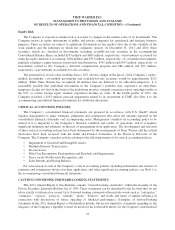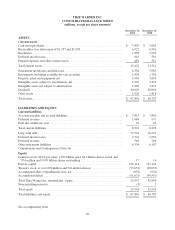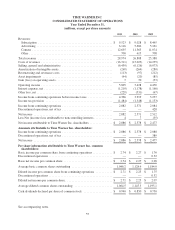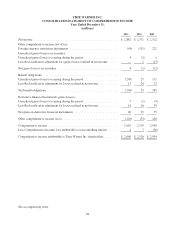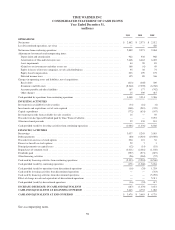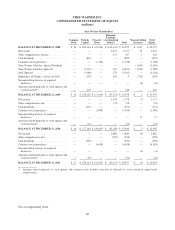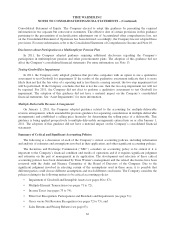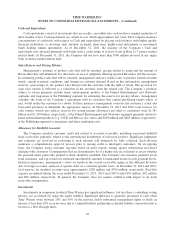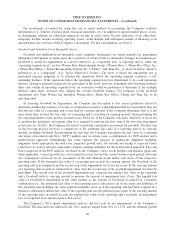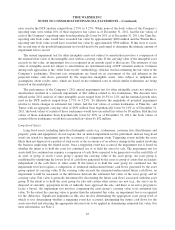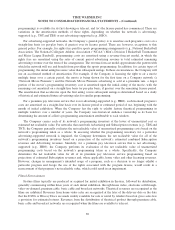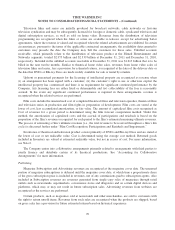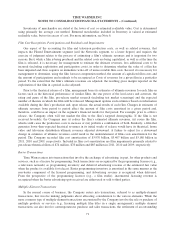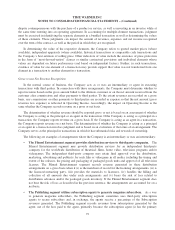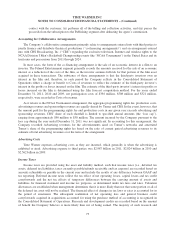Time Magazine 2011 Annual Report Download - page 77
Download and view the complete annual report
Please find page 77 of the 2011 Time Magazine annual report below. You can navigate through the pages in the report by either clicking on the pages listed below, or by using the keyword search tool below to find specific information within the annual report.TIME WARNER INC.
NOTES TO CONSOLIDATED FINANCIAL STATEMENTS – (Continued)
Cash and Equivalents
Cash equivalents consist of investments that are readily convertible into cash and have original maturities of
three months or less. Cash equivalents are carried at cost, which approximates fair value. The Company monitors
concentrations of credit risk with respect to Cash and equivalents by placing such balances with higher quality
financial institutions or investing such amounts in liquid, short-term, highly-rated instruments or investment
funds holding similar instruments. As of December 31, 2011, the majority of the Company’s Cash and
equivalents were invested primarily with banks with a credit rating of at least A and in Rule 2a-7 money market
mutual funds. At December 31, 2011, the Company did not have more than $500 million invested in any single
bank or money market mutual fund.
Sales Returns and Pricing Rebates
Management’s estimate of product sales that will be returned, pricing rebates to grant and the amount of
Receivables that will ultimately be collected is an area of judgment affecting reported Revenues and Net income.
In estimating product sales that will be returned, management analyzes vendor sales of product, historical return
trends, current economic conditions, and changes in customer demand. Based on this information, management
reserves a percentage of any product sales that provide the customer with the right of return. The provision for
such sales returns is reflected as a reduction in the revenues from the related sale. The Company’s products
subject to return primarily include home entertainment product at the Filmed Entertainment and Networks
segments and magazines at the Publishing segment. In estimating the reserve for pricing rebates, management
considers the terms of the Company’s agreements with its customers that contain purchasing targets which, if
met, would entitle the customer to a rebate. In those instances, management evaluates the customer’s actual and
forecasted purchases to determine the appropriate reserve. At December 31, 2011 and 2010, total reserves for
sales returns (which also reflects reserves for certain pricing allowances provided to customers) were $1.381
billion and $1.249 billion, respectively, at the Filmed Entertainment and Networks segments primarily related to
home entertainment products (e.g., DVD and Blu-ray disc sales) and $296 million and $405 million, respectively,
at the Publishing segment for magazines and direct marketing sales.
Allowance for Doubtful Accounts
The Company monitors customer credit risk related to accounts receivable, including noncurrent unbilled
trade receivables primarily related to the international distribution of television product. Significant judgments
and estimates are involved in evaluating if such amounts will ultimately be fully collected. Each division
maintains a comprehensive approval process prior to issuing credit to third-party customers. On an ongoing
basis, the Company tracks customer exposure based on news reports, ratings agency information and direct
dialogue with customers. Counterparties that are determined to be of a higher risk are evaluated to assess whether
the payment terms previously granted to them should be modified. The Company also monitors payment levels
from customers, and a provision for estimated uncollectible amounts is maintained based on such payment levels,
historical experience, management’s views on trends in the overall receivable agings at the different divisions
and, for larger accounts, analyses of specific risks on a customer specific basis. At December 31, 2011 and 2010,
total reserves for doubtful accounts were approximately $280 million and $324 million, respectively. Bad debt
expense recognized during the years ended December 31, 2011, 2010 and 2009 totaled $30 million, $42 million
and $84 million, respectively. In general, the Company does not require collateral with respect to its trade
receivable arrangements.
Investments
Investments in companies in which Time Warner has significant influence, but less than a controlling voting
interest, are accounted for using the equity method. Significant influence is generally presumed to exist when
Time Warner owns between 20% and 50% of the investee, holds substantial management rights or holds an
interest of less than 20% in an investee that is a limited liability partnership or limited liability corporation that is
treated as a flow-through entity.
63


